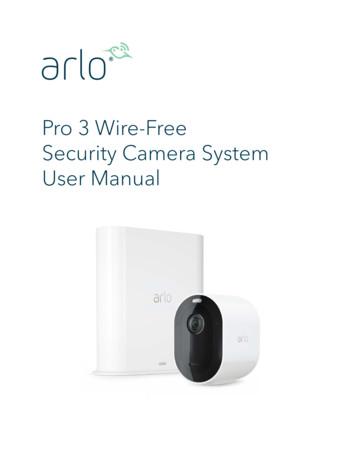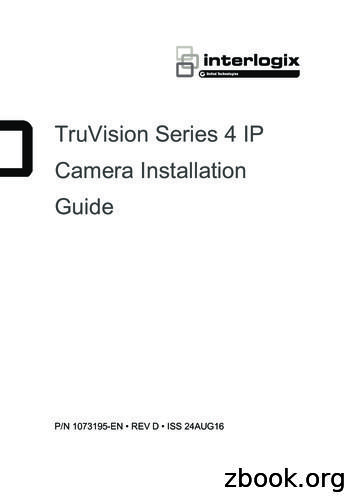A CAMERA HANDBOOK - EPFL
A CAMERA HANDBOOKFilippo FanciottiHow to frame a scene is as much relevant as the scene itself, including allthe choices concerning a certain point of view, a particular focal length,the shape of the layout and so on. This apparatus involves decisionssupporting the story told by a painting, enhancing effects linked toa particular artistic genre or movement, a pictorial technique or anexpressive intent.Since these settings are real choices in the real world, it becomesextremely important to be conscious of the available options provided byrendering softwares when shifting to the virtual dimension - from how tochose a layout to how to set up a camera - since not taking any choice is achoice itself, simply taken by the programmers of that engine when calledto define the default settings.The Music LessonJohannes Vermeer1662-1665oil on canvas74.6 cm 64.1 cmRoyal Collection, St. James’sPalace, LondonThe Vermeer’s Music Lesson,camera variation: reverse shotFilippo Fanciottinovember 2017Rhino, V-ray, Photoshop1465 x 1465 pixelsEPFL, ENAC, LAPISFiRe 3 2018
Camera widget1. Camera viewpoint.125642. Camera location (can be used tomove the whole camera widget).3. Target point34. Roll control (to tilt the camera).75. The field of view/lens angle6. Near clipping plane (nothingvisible “before”)7. Far clipping plane (nothingvisible “after”)Any numerical camera iscomposed by a series ofelements recreated in order toprovide a realistic control of it.Besides the viewpoint (1. theplace where you are lookingfrom) and the target (3. thepoint you are staring at) thereis a widget to control therotation of the camera -so howto tilt it (4.), another one toopen up or decrease the field ofview, so manually changing thelens length, as well as a pair ofideal surfaces delimiting thebeginning (6.) and the ending(7.) of the visible portion ofspace captured by the camera.exposure of a scene, being therendering a simulation of thephotography act happening inreal life [We'll face this topic inthe lighting handbook].Mind that the Physical camera- e.g. so named in Vray - is alsothe tool to control the light1567613drawings from "Vermeer's camera, uncovering the Truth Behind the Materpiece", Philip SteadmanFiRe 3 2018 CAMERA HANDBOOKLAPIS
lens lengthVML : Vermeer Music Lessonfocal length[ FF]50 mm135 mm900 mm600 mm400 mm300 mm105 mm35 mm28 mm18 mm11 mm85 mm200 mmVML4 4 10'6 10'8 10'12 20'18 The focal length tells us theangle of view - how much ofthe scene will be captured and the magnification - howlarge individual elements willbe -.FiRe 3 2018 CAMERA HANDBOOK23 20'28 30'180 46 62 74 100 A proper management of thelens length is necessary not onlyto include portions of spaceotherwise not visible with, forexample, a lower angle, butalso to enphasize a personalexpressive intent (i.e. if usedin an interior, by radicallyenhancing depth and distortingnearby objects, a very shortfocal normally gives a sense ofanxiety, almost of vertigo, tothe viewer).22.5 mm (original)30 mm40 mm18 mm10 mm5 mm (previous page)LAPIS
camera rotationA camera rotation can add alot of dynamism to your scene,specially if combined with aproper lens length (see previouschapter).Although this kind of shot hasbeen long more used in thecinematography environment- i.e. the Dutch Angle, a shotin which the camera angle isdeliberately slanted to oneside, used for dramatic effect toportray unease, disorientation,madness, etc. - it is not unusualin the history of art as well,in fact you may notice thatthe Vermeer Music Lesson isalready a camera rotation case,which we straightened only foreducational purposes.Inception, Christopher Nolan, 2010, Warner Bros (US, UK)0 lens legth 22.5 [mm]FiRe 3 2018 CAMERA HANDBOOK25 lens legth 22.5 [mm]341 lens legth 10 [mm]LAPIS
camera typesBasically, in a rendering enginethe type of camera determineshow the scene (what you see,the model) is projected onto thescreen (once you render it to geta bidimensional projection).The behavior of the rays castinto the scene can changeaccording to the type of cameraused.Besides the standard camera(usually a pinhole), there areother types of camera, each oneworking with different lensesand, therefore, rendering adifferent projection of thescene. The most common are:FiRe 3 2018 CAMERA HANDBOOKAs shown in the followingexamples, with override FOVsetting the renderer overridesthe Field of View angle.(because some camera types cantake FOV ranges from 0 to 360 .)This kind of camera can beuseful to make HDRI likeimages. Cylindrical (point)(2)all rayscast from the center of a cylinder;- z axis (vertical direction):thecamera acts as a pinhole camera- x,y axis (horizontal direction):spherical camera.12 Spherical camera (1): thelenses has spherical form. Cylindrical (ortho) (3) –Like the previous one, but withthe camera acting as an orthoview in the vertical direction.3spherical camera ov. FOV 45 spherical camera ov. FOV 90 spherical camera ov. FOV 180 cylindrical camera ov. FOV 20 cylindrical camera ov. FOV 60 cylindrical camera ov. FOV 100 LAPIS
Fisheye lensFisheye lenses are exasperatedwide-anglelensesableto produce strong visualdistortion to create widepanoramics or hemisphericalimages. "Instead of producingimages with straight linesof perspective (rectilinearimages), fisheye lenses use aspecial mapping (for example:equisolid angle), which givesimages a characteristic convexnon-rectilinear appearance."sourceFisheye captures the scene asif it is normal pinhole camerapointed at an absolutelyreflective sphere which reflectsthe scene into the camera’sshutter.As the value approaches 0.0 thewarping is increased.curve - fisheye main parameter- contorts the way therendered image is warped.A value of 1.0 corresponds toa real world Fish-eye camera.2001 A Space Odyssey, Stanley Kubrick, 1968, MGM (US, UK)fisheye ov.FOV 20,dis.t 2.0, crv 1.0FiRe 3 2018 CAMERA HANDBOOKfisheye ov.FOV 20,dist. 2.0, crv 0.5fisheye ov FOV 20, dist 2.0, crv 0.1LAPIS
Box camera"Box – Six standard camerasplaced on the sides of a box,generating a vertical crossformat image.This type of camera is excellentfor generation of environmentmaps for cube mapping. TheBox camera can also be used forgenerating irradiance maps forGI: First you would calculatethe irradiance map with a Boxcamera, then save it to a file andFiRe 3 2018 CAMERA HANDBOOKfinally reuse it with a Defaultcamera that can be pointed inany direction."than that complex process canbe obtained just turning on thisoption.source (chaosgroup.com)Although it is a very specificfeatureofsotwarelikeVray, the Box camera turnsinto something extremelyinteresting looking at thenotorious Peepshow by SamuelVan Hoogstraten and imaginePeepshow faces with Views ofthe interor of a Dutch houseSamuel Van Hoogstraten1655-60National Gallery, LondonLAPIS
camera location and targetIn the representation ofarchitecture it is customarythat the position of the eyesand the gaze coincide, so thatthe vertical lines do not gotoward a vanishing point and,consequently, are straight as inan orthogonal projection.Although this is really a goodnorm, it should not be takenas an incontestable principle,since moving around the sceneand changing the target canlead to other narrative lines,otherwise excluded in a moreclassical representation.FiRe 3 2018 CAMERA HANDBOOKVertigo, Alfred Hitchcock ,1958, Paramount (US)his notorious Vertigo.We can find an exceptionalexampleofcombinedmanagement of point of view,zoom (thus focal length change)and camera position in thedolly zoom (or vertigo effect),invented by Alfred Hitchcock inz loc. 5 z target 5 lens 22.5z loc. 5 z target 250 lens 22.5z loc. 5 z target 25 lens 10z loc. 270 lens 10z loc. 270 lens 22.5reverse shotLAPIS
focus and layoutabbaaThe center of the canvas isneither coinciding with thevanishing point neither withanyrelevantgeometricalelement -.abThe vanishing point is displacedfrom the center of the canvas,focusing the apix of the dramaon the arm of the lady, intentedto play at the virginals.aaThe vanishing point is displacedfrom the center of the canvas,I decided to let it coincidewith the edge between the walland the window on the right,therefore enpoweing that line.acbbaacbbccthe front wall occupies thespace between the pavementand the left wall, inscribing thecore of the scene in a perfectsqaure.FiRe 3 2017LAPISas in a scenic stage, three lineshave the function of framingthe scene, so letting theobserver gradually approachthe representation: on the leftthe edge of the window, on theright the border of the CaritasRomana painting, the lastwooden beam of the ceilingabove.as in a scenic stage, three lineshave the function of framingthe scene, so letting theobserver gradually approachthe representation: on the leftthe edge of the window, on theright the border of the CaritasRomana painting, the lastwooden beam of the ceilingabove.LAPIS
Gestaltic proportionsbaa2ba2aThe vanishing point is - like inVermeer's Music lesson - notat the centre of the scene, buta bit shifted. I decided to let itcoincide with the edge betweenthe wall and the window on theright, therefore enpoweing thatline.bThe other edge of the windowdivides the image in two equalparts, so .cThe proportion between thevisible parts of ceiling andpavement is central in thecomposition : here the floor istwice the ceiling.d2bdb2bcathe "b 2b" proportion isrepeated twice, theredoregenerating a rhythm betweenceiling, windows, wall andpavement.lhe limit of the pavement andthe beginning of the otherwindow are equally distant fromthe border of the drwing, thusgenerating a square includingthe core of the scene.main areas/linescompositionofthe2aFiRe 3 2018 CAMERA HANDBOOKLAPIS
FiRe 3 2018 CAMERA HANDBOOK
fisheye ov.FOV 20,dis.t 2.0, crv 1.0 fisheye ov.FOV 20,dist. 2.0, crv 0.5 fisheye ov FOV 20, dist 2.0, crv 0.1 Fisheye lens Fisheye lenses are exasperated wide-angle lenses able to produce strong visual distortion to create wide panoramics or hemispherical images. "Instead of producing images with straight lines of perspective (rectilinear
2-9V in unit & 2 AA in camera. Match polarities ( ) and ( ). Set camera date back, close camera lens and connect plug to camera port. 2 3 Secure camera, open camera shutter, and slide unit power switch to (ON) and back to (OFF), then push camera test button. Close camera Shutter, remove camera & load film, connect plug to camera, close cover. 4
User Manual Replace a Pro 3 Camera battery You can leave the camera housing in place so the camera position stays the same. 1. Release the camera from the camera housing. Press the button on the charging port underneath the camera. The camera clicks as it disengages from the camera housing. 2. Pull the camera all the way out of the camera .
Everything you always wanted to know about multicore graph processing but were afraid to ask Jasmina Malicevic EPFL Baptiste Lepers EPFL Willy Zwaenepoel EPFL Abstract Graph processing systems are used in a wide variety of fields, ranging from biology to social networks, and a large num
Camera CCH-01G Jeep Grand Cherokee Camera CMB-16G Mercedes Benz GLK Trunk Handle Camera CCH-01S Jeep Wrangler Spare Tire Mount Camera CVW-07L VW Beetle License Plate Light Camera (LED) CVW-07G VW Beetle License Plate Light Camera CFD-03F Ford Tailgate Handle Camera CCH-01W Jeep Wrangler License Plate Light Camera CBM-01T BMW 5 Series Trunk .
1. Place the outdoor mount and secure it with screws. For drywall, use the wall anchors we provide. 2. Release the camera from the camera housing. Press the button on the charging port underneath the camera. The camera clicks as it disengages from the camera housing. 3. Pull the camera all the way out of the camera housing. 4.
On power-up, the camera interface board will read the SW1 DIP switches and set the camera video mode accordingly. If the DIP switches are set for 'Default Camera Mode' then the camera (and camera interface . Serial Camera Control The camera may be controlled by serial VISCA commands (J3). The VISCA serial signal is routed through the .
2 Installation Guide Introduction Product overview This is the installation guide for TruVision Series 4 IP camera models: TVC-5401 (2MPX IP box camera) TVC-5402 (3MPX IP box camera) TVC-5403 (5MPX IP box camera) TVB-5401 (2MPX IP bullet camera, 2.8 to 12 mm) TVB-5402 (2MPX IP bullet camera, 8 to 32 mm)
Viper Digital Cinematographic Camera Operator's Manual The Viper FilmStream Camera combines two different application concepts in a single camera. By selecting the operation mode, the camera operates either as a HD video camera or as a digital film camera. The digital film camera mode is known as the FilmStream mode. Using this manual























